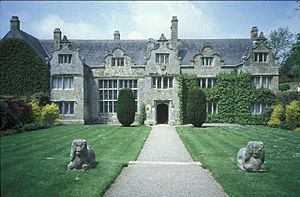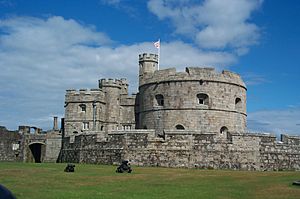Richard Arundell, 1st Baron Arundell of Trerice facts for kids
Quick facts for kids
Richard Arundell, 1st Baron Arundell of Trerice
|
|
|---|---|

Trerice House, Cornwall
|
|
| Governor of Pendennis Castle | |
| In office 1662–1687 |
|
| Deputy Lord Lieutenant of Cornwall | |
| In office 1662–1687 |
|
| Member of Parliament for Bere Alston |
|
| In office January 1662 – March 1665 |
|
| Member of Parliament for Lostwithiel |
|
| In office November 1640 – January 1642 (excluded) |
|
| Personal details | |
| Born | c. 1616 Trerice |
| Died | 7 September 1687 (aged 71) London |
| Resting place | St James's Church, Piccadilly |
| Nationality | English |
| Spouse | Gertrude Bagge (1645-his death) |
| Children | John Arundell, 2nd Baron Arundell of Trerice |
| Alma mater | Lincoln's Inn |
| Occupation | Landowner, politician and soldier |
| Military service | |
| Years of service | 1642 to 1646 |
| Rank | Colonel |
| Battles/wars | First English Civil War Edgehill; Lansdowne; Bristol; Siege of Pendennis Castle |
Richard Arundell, 1st Baron Arundell of Trerice (born around 1616, died 7 September 1687) was an important English politician and soldier. He came from Trerice in Cornwall. He was a member of the House of Commons, which is like a part of today's Parliament. He also fought as a Royalist soldier during the First English Civil War. Later, he was given a special title and became a Baron.
Contents
Who Was Richard Arundell?
Richard Arundell was born around 1616 in a place called Trerice in Cornwall. He was the second son of Sir John Arundell and Mary Cary. Richard had five brothers and sisters: John, William, Francis, Agnes, and Mary.
The Arundell family of Trerice was a smaller part of a much larger and very rich family in Cornwall. This bigger family was known as the Arundells of St Mawgan.
His Family Life
Richard's youngest sister, Mary, first married a man named John Trevanion. Sadly, John was killed in 1643 during a battle in Bristol. Later, in 1674, Mary married again, this time to Richard's cousin, John Arundell of Lanherne.
Richard Arundell married Gertrude Bagge. Gertrude was the daughter of Sir James Bagge. She was also the widow of Sir Nicholas Slanning, who was also killed at Bristol in 1643. Richard and Gertrude had one son who lived, named John Arundell, 2nd Baron Arundell of Trerice.
Richard's Early Career
In 1633, Richard Arundell began studying law at Lincoln's Inn. He became a qualified lawyer in 1640. That same year, he helped his older brother with a legal case.
Becoming a Member of Parliament
In April 1640, Richard was chosen to be a MP for Lostwithiel. This was for a short time, in what was called the Short Parliament. He was then chosen again for the Long Parliament in November.
However, in January 1642, Richard was removed from Parliament. This happened because he followed an old rule called the Commission of array. This rule allowed the King to gather soldiers and money, which Parliament did not agree with at the time.
Fighting in the English Civil War
The First English Civil War started in August 1642. Richard Arundell joined the Royalist army, who supported King Charles I. He is believed to have fought in important battles like Edgehill and Lansdowne.
A famous historian named Clarendon described Richard as "a stout and diligent officer." This means he was a brave and hardworking soldier. His main job was to collect taxes to help pay for the Royalist war effort.
Richard served under his father at Pendennis Castle. This castle was a very important place. It protected King Charles II of England and Queen Henrietta Maria during the war. Pendennis Castle was one of the last places to surrender to the Parliament's army in August 1646.
Life After the War
Richard's older brother, John, was killed in 1644 near Plymouth. So, when their father died in 1654, Richard inherited the family's lands and wealth.
During the time when England was ruled without a king (called the Interregnum), Richard continued to secretly support the Royalists. But he was careful and managed to avoid being arrested.
Return to Politics and Wealth
After the King returned to power in June 1660 (this was called the Stuart Restoration), Richard was again elected as an MP. This time, he represented Bere Alston in the Convention Parliament.
In 1662, King Charles II gave Richard two important jobs. He became the Governor of Pendennis Castle and the Deputy Lord Lieutenant of Cornwall. He kept both of these jobs until he died in 1687.
In January 1662, Richard was re-elected as an MP for Bere Alston. He served in Parliament until March 23, 1664. On that day, he was given a special title and became Baron Arundell of Trerice. This meant he was now a member of the nobility.
Over the next 20 years, Richard became very rich. In 1674, he received a gift of £3,000, which was a huge amount of money back then. He also received a pension of £1,000 every year. Richard Arundell died in London on September 7, 1687.


